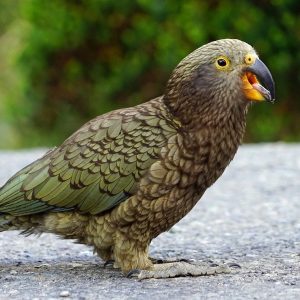 As time passes, we come to discover more about a parrot’s intelligence. Not that we were in any doubt of their brain power, of course. But with a restless science community intent on validation of what we already believe to be so, countless studies are beginning to verify reality in startling episodes of discovery.
As time passes, we come to discover more about a parrot’s intelligence. Not that we were in any doubt of their brain power, of course. But with a restless science community intent on validation of what we already believe to be so, countless studies are beginning to verify reality in startling episodes of discovery.
In previous studies, we have learned that birds can create tools to benefit their immediate needs. We have seen studies that show some birds to enlist the help of other birds to achieve a desired end. Now, as we advance in scientific studies on birds, we are discovering that kea parrots (for this study) can use their intelligence to contemplate several examples of potential outcomes before selecting a path of best execution. Simply put, these parrots are evaluating, and reasoning based on probable assumption. Amazing! This is the first-time science has witnessed this behavior apart from the great apes.
Statistical Whizzes
In early March, Doctoral candidate and biologist, Amalia P. M. Bastos, and Alex H. Taylor, an Associate Professor at the University of Auckland, published their advanced findings in Nature Communications. Previously (December 2019), the two scientists published the findings of a similar study with the Kea parrot that found the birds could envision hidden objects after the objects left their view and determine where they would end up. This indicates a distinct reasoning capability using two factors simultaneously and combining them to arrive at a predicted conclusion. Humans enjoy this seemingly unique capability of intelligence as do gorillas and chimpanzees.
An example is watching a person move from sight and into another room and knowing the probable location of the person. Or seeing a bird fly behind a tree and expecting to see the same bird fly from the other side of the tree. These examples are referred to as object trajectory.
In the March issue of Nature, the two scientists discovered further that Kea parrots use even more advanced reasoning and predictive skills. Essentially, it was determined that the New Zealand Kea could utilize their brain using multiple sources of information crossing paths at the same time to come up with a viable prediction. That is to say, a physical view coupled with two levels of probability could generate a predictive outcome with which to act upon. This finding gave scientists more information on the developing evolution of complex intelligence. The realized fact that a non-primate could use intelligence to make a complex assessment is exciting.
In the second study, three experiments were given to six Kea parrots. After several presentation of facts under the controlled experiments, the parrots often chose the solution with the most probable collection of rewards. The tests were jars of tokens, some of which yielded rewards and some which did not. After being presented with certain facts, and after a time, the Kea parrots soon showed remarkable intelligence in the selection of better rewards based on probability factors.
One of the likely benefits of these remarkable studies is the advancement of Artificial Intelligence (AI) in its coded understanding of human thinking and reasoning. To get a more scientific but fuller understanding of this set of studies, you can begin with the December issue of Nature (here), and the subsequent March issue (here). One thing is certain: we’re about to learn and validate much more about our birds and their intelligence.
